
About UsThe Numismatic Bibliomania Society is a non-profit organization promoting numismatic literature. For more information please see our web site at coinbooks.org SubscriptionsThose wishing to become new E-Sylum subscribers (or wishing to Unsubscribe) can go to the following web page link MembershipThere is a membership application available on the web site Membership Application To join, print the application and return it with your check to the address printed on the application. Membership is only $15 to addresses in the U.S., $20 for First Class mail, and $25 elsewhere. For those without web access, write to: David M. Sundman, Secretary/TreasurerNumismatic Bibliomania
Society AsylumFor Asylum mailing address changes and other membership questions, contact David at this email address: dsundman@LittletonCoin.com SubmissionsTo submit items for publication in The E-Sylum, just Reply to this message, or write to the Editor at this address: whomren@coinlibrary.com
BUY THE BOOK BEFORE THE COINYou won't regret it! |
- WAYNE'S WORDS: THE E-SYLUM OCTOBER 18, 2009
- NEW BOOK: FANCY FIGURAL AND UNUSUAL SEAL PRESSES
- NEW BOOK: NUMISMATIQUE ET ARCHÉOLOGIE EN POITOU-CHARENTES
- PRICE LIST: HOLABIRD-KAGIN SUMMER 2009 MINT STATE PIONEER MINOR COINAGE
- UPDATE ON THE FRANK H. STEWART - FIRST MINT BOOK
- STOP! ENOUGH OF THE SPECIAL REDBOOKS ALREADY!
- FOLLOW-UP: SAINT-GAUDENS COINAGE OF THE AMERICAS CONFERENCE
- DICK JOHNSON: NEW MEDAL, NEW BUSINESS, PART TWO
- QUERY: INFORMATION ON TEMPERANCE SOCIETY MEDALS AND TOKENS SOUGHT
- MORE ON THE 1783 NOVA CONSTELLATIO PATTERN SET
- COIN DEALER JULIAN LEIDMAN VICTIM OF VEHICLE BURGLARY
- NOTES AND COMMENTS ON LAST WEEK'S ISSUE
- NUMISMATICS IN FICTION: 'THE COIN' AND 'LOOSE COINS'
- NINE-YEAR-OLD GIRL DESIGNS COIN FOR LONDON 2012 OLYMPICS
- DEAD MAN'S EYE COVERED WITH AN ANTI-SLAVERY TOKEN
- THE DOG ATE MY PAPER MONEY COLLECTION
- FEATURED WEB PAGE: GUERNSEY TOKENS
WAYNE'S WORDS: THE E-SYLUM OCTOBER 18, 2009

Among our recent subscribers are Laurent Comparot of France, and Keith Wagner. Welcome aboard! We now have 1,270 subscribers.
This week we open with reviews of a couple new books of interest to numisamtists, and a book-like fixed price list of pioneer tokens from Fred Holabird. Next we have an update from Len Augsburger and Joel Orosz on their upcoming book about Frank H. Stewart and the first United States Mint.
In follow-ups from last week we have comments on the plethora of special Redbooks, part two of Dick Johnson's series on the making of the 2009 Victor David Brenner Lincoln medal, and more on the 1783 Nova Constellatio pattern set.
A featured article this week concerns the heartbreaking loss of dealer Julian Leidman's inventory to thieves who broke into his vehicle last week. We describe and illustrate a number of highly identifiable pieces and encourage readers to be on the lookout.
To learn about anti-drinking and anti-slavery tokens, the Royal Mint's nine-year-old coin designer, and the dog who ate a paper money collection, read on.
Wayne Homren
Numismatic Bibliomania Society
NEW BOOK: FANCY FIGURAL AND UNUSUAL SEAL PRESSES
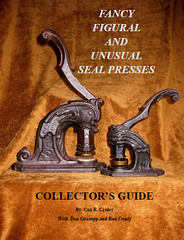 I know what you're thinking - what the heck are seal presses and what do they have to do with numismatics? Well, when I heard about this book from Dave Bowers, I knew there was a neat connection lurking somewhere. First, here's a definition of a seal press:
I know what you're thinking - what the heck are seal presses and what do they have to do with numismatics? Well, when I heard about this book from Dave Bowers, I knew there was a neat connection lurking somewhere. First, here's a definition of a seal press:
These devices would impress a raised seal on a piece of paper, serving as an official mark of authenticity, difficult to reproduce without access to the original equipment. Notary Publics used these, although today most use a smaller hand-held version.
Seal embossing presses consist of two major types: percussion (struck with fist or palm) or lever (much more efficient). Although these were most widely used from the 1850's through the 1950's, there are few serious collectors of these neat historical items.
 The seal would include text and/or images chosen by the owner of the seal. Typically the buyer would commission an engraver to create an appropriate custom design for their seal. As you've probably guessed by now, this is where the numismatic connection comes in - many seal engravers were also engravers of coins, medals and tokens. There are also tokens which picture seal presses.
The seal would include text and/or images chosen by the owner of the seal. Typically the buyer would commission an engraver to create an appropriate custom design for their seal. As you've probably guessed by now, this is where the numismatic connection comes in - many seal engravers were also engravers of coins, medals and tokens. There are also tokens which picture seal presses.
One such token is the Merriam toad press token. Dave provided the image for the book, and you will find it prominently displayed on the back cover.
Dave put me in touch with Don Grampp, who writes:
This is the first book available for the collector of American seal presses. This 113-page book describes over 160 different body styles. Information is included about presses from several Civil War era die sinkers such as Merriam and Childs.
The coil bound volume is printed on heavy weight glossy paper. The book is available for $50.00 plus $4.00 postage and shipping by contacting grampp@sbcglobal.net .
Here are a few images of the internal pages. Click on the image to access larger versions on our Flickr archive.
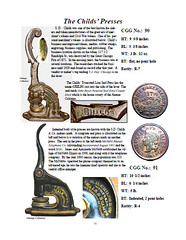 S. D. Childs was one of the best known die sink-ers and token manufacturers of the great era of merchant's tokens and Civil War tokens. One of his personal merchant's tokens is illustrated below. Child's business encompassed tokens, medals, rubber stamps, engraving, business supplies, and publishing.
S. D. Childs was one of the best known die sink-ers and token manufacturers of the great era of merchant's tokens and Civil War tokens. One of his personal merchant's tokens is illustrated below. Child's business encompassed tokens, medals, rubber stamps, engraving, business supplies, and publishing.
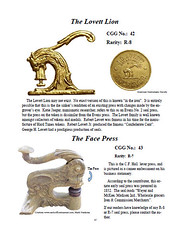 Katie Jaeger, numismatic researcher, refers to this as an Evens No. 2 seal press, but the press on the token is dissimilar from the Evens press. The Lovett family is well known amongst collectors of tokens and medals. Robert Lovett was famous in his time for the manufacture of Hard Times tokens. Robert Lovett Jr. produced the famous "Confederate Cent". George H. Lovett had a prodigious production of seals.
Katie Jaeger, numismatic researcher, refers to this as an Evens No. 2 seal press, but the press on the token is dissimilar from the Evens press. The Lovett family is well known amongst collectors of tokens and medals. Robert Lovett was famous in his time for the manufacture of Hard Times tokens. Robert Lovett Jr. produced the famous "Confederate Cent". George H. Lovett had a prodigious production of seals.
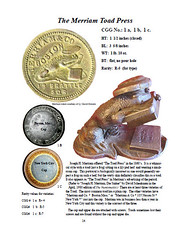 Joseph H. Merriam offered "The Toad Press" in the 1860's. It is a whimsical style with a toad (not a frog) sitting on a lily pad leaf and wearing a mushroom cap. This portrayal is biologically incorrect as one would generally expect a frog on such a leaf, but the warty skin definitely classifies this as a toad. It also appears as "The Toad Press" in Merriam's advertising of the period. (Refer to "Joseph H. Merriam, Die Sinker" by David Schenkman in the April, 1980 edition of The Numismatist.) There are at least three varieties of the Toad.
Joseph H. Merriam offered "The Toad Press" in the 1860's. It is a whimsical style with a toad (not a frog) sitting on a lily pad leaf and wearing a mushroom cap. This portrayal is biologically incorrect as one would generally expect a frog on such a leaf, but the warty skin definitely classifies this as a toad. It also appears as "The Toad Press" in Merriam's advertising of the period. (Refer to "Joseph H. Merriam, Die Sinker" by David Schenkman in the April, 1980 edition of The Numismatist.) There are at least three varieties of the Toad.
For more information, see: www.sealpresscollector.com/SEAL_PRESS.html
Many thanks to Dave for passing on word of this book.
NEW BOOK: NUMISMATIQUE ET ARCHÉOLOGIE EN POITOU-CHARENTES
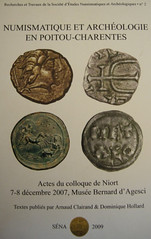 The colloquium NUMISMATIQUE ET ARCHÉOLOGIE EN POITOU-CHARENTES took place in the Museum Bernard d'Agesci in Niort the 7 and 8 December 2007.
The colloquium NUMISMATIQUE ET ARCHÉOLOGIE EN POITOU-CHARENTES took place in the Museum Bernard d'Agesci in Niort the 7 and 8 December 2007.
It covers from the Drachms and Stators Picto-santon up to the money made of the metal (Bronze) of the bells during the French Revolution. This book regroups 15 studies unpublished covering 20 centuries of production and monetary circulation in the French Poitou-Charentes region.
Seven of the contributions are concerning the Melle production centre (under the Merovingians and the Carolingians) and the Montreuil-Bonnin production centre (13th and 14th Centuries). Archives documents, metal analysis and archaeological data complete each other to enrich and renew our knowledge on these major sites for the French national and regional monetary histories.
To order, see the web site of the Société d'Etudes Numismatiques et Archéologiques (or "SENA"): www.sena.fr
PRICE LIST: HOLABIRD-KAGIN SUMMER 2009 MINT STATE PIONEER MINOR COINAGE
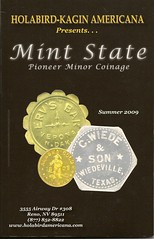 Fred Holabird sent me a copy of the Holabird-Kagin Americana Summer 2009 fixed price list of pioneer tokens. While fundamentally a marketing document, the production values are high - this 168-page perfect bound softcover catalog makes a respectable book. With its focus on mint state tokens, the color photographs are attractive. Organized alphabetically by state and town, it's easy to find tokens by location, but there is no index of merchant names.
Fred Holabird sent me a copy of the Holabird-Kagin Americana Summer 2009 fixed price list of pioneer tokens. While fundamentally a marketing document, the production values are high - this 168-page perfect bound softcover catalog makes a respectable book. With its focus on mint state tokens, the color photographs are attractive. Organized alphabetically by state and town, it's easy to find tokens by location, but there is no index of merchant names.
There is no shortage of obscure town names, which makes for interesting reading even if one is not a collector of these tokens: Alakunuk "wrong way", Alaska, Bisbee (and of course, Tombstone), Arizona, Susanville, California, Owyhee and Winnemucca, Nevada.
In the Introduction I learned about the Anillo Restrikes, uniface restrikes of tokens from original dies made by Anillo Industries in Orange, California in 1968.
For more information, see the company's web site: www.holabirdamericana.com
THE BOOK BAZARRE
UPDATE ON THE FRANK H. STEWART - FIRST MINT BOOK
Since 2006, we have been doing intensive research on Frank H. Stewart, the owner, chronicler, would-be savior, and ultimate destroyer of the first United States Mint, and the rich legacy of Mint-related artwork he left behind. We have visited more than a dozen archival repositories located in four states plus the District of Columbia, connected with collectors living in more than 10 other states, and carefully combed the Internet.
The rich collections we examined have yielded discoveries that will excite everyone intrigued by American numismatic history. We unearthed new facts about the construction and evolution of the buildings of the first Mint, tracked down its artifacts and relics—such as a doorstep of one of the buildings and gavels made from salvaged Mint building timbers—and uncovered a great deal of biographical information about Frank H. Stewart himself.
We have traced missing rarities that will excite coin collectors in general, but early copper enthusiasts in particular. Visually, the book will be truly eye-popping. We have gathered remarkable images of the first Mint completely unseen since they were created decades ago — photographs, sketches, studies, watercolors — not to mention a forged oil painting!
The coins and medals from Frank H. Stewart's collection illustrated in the book will be fresh material even to advanced collectors. Our copiously-illustrated book will literally change the way in which we look at the Mint, its history, and the art that has shaped our perceptions of it for the past century. Pictures of the First United States Mint: The Numismatic Legacy of Frank H. Stewart will be available in mid-2010 from Whitman Publishing.
- The cover from the program for the fourth US Mint dedication (1969), featuring an adaptation of Edwin Lamasure's Ye Olde Mint.
- Frank H. Stewart, c. 1945, enjoying a good smoke and a good read.
- The doorsill of the first United States Mint.
- A gavel constructed from first Mint timber (ANA collection).
-Editor
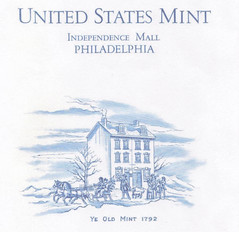
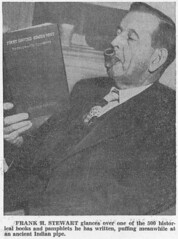
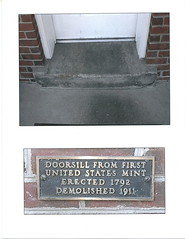
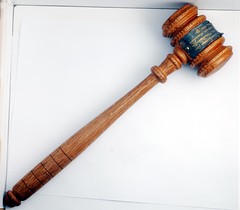
STOP! ENOUGH OF THE SPECIAL REDBOOKS ALREADY!
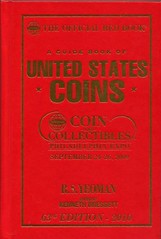
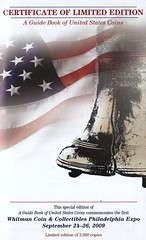
One E-Sylum reader, though, is saying "Enough already!" with the various special editions. -Editor
I have a collection of "Redbooks" that is regarded as the one of the finest in existence. The point to the collection has never been in acquiring everything, nor has it ever been about personal recognition and boasting, nor has it been about its financial worth. The reason that it was begun in earnest and has continued for 20+ years is due to the passing of Mr. Richard Yeo (R.S. Yeoman) and the admiration for him as a person and a role model.
Using "The Numismatist" article by Ms. Ginger Rapsus as a basic guide I have collected virtually everything possible in that article and beyond as a tribute to Mr. Yeoman. In adding to the collection I have found that the greatest value came in the new friends and relationships that developed as a result. To Mr. Ken Bressett, my admiration for you equals that of Mr. Yeo because of your character. With all of this said, I have decided to stop actively collecting the "Redbook".
The recent publications of the "Philadelphia" and the "Professional" editions are literally "ENOUGH is ENOUGH"! All of the different and specialty versions of the "Redbook" that are and have been produced under the current ownership of Whitman are done so to exploit a market of collectors. NONE of these books are necessary or relevant. They are a waste of trees.
Because this vehicle is subscribed to by serious numismatists and bibliophiles they are the audience that is targeted to purchase and collect these prefabricated collectibles. They are purchased as a new collectible, they will remain as a new collectible, and they will be resold as a new collectible with the entire production remaining new and a copy being constantly available somewhere when a new collector wants one. There is no intrinsic value to them and the supply will always vary depending upon current demand. When a market correction takes place and the values drop substantially to more realistic values the collector base will shrink accordingly and demand will wane.
The "Redbook" and "Bluebook" are really OBSOLETE. The prices are outdated because they are compiled many months before publication. There are many other timely publications in print that state values and for up to the minute prices one has only look to the very computer they're reading this on to find what they need. The basic facts about coins can be found in many sources, but in a small concise format such as the "Redbook" it needs publication only sparingly.
The "Redbook" is just a "Guide Book" as it states and it no longer properly assists the non-collecting public in evaluating what they possess. This can't possibly be what Mr. Richard Yeo envisioned for his books. Please stop debasing the value of the "Redbook" with the frivolous production varieties.
To read the earlier E-Sylum article, see: NEW BOOK: 2010 PHILADELPHIA EXPO RED BOOK (www.coinbooks.org/esylum_v12n41a04.html)
FOLLOW-UP: SAINT-GAUDENS COINAGE OF THE AMERICAS CONFERENCE
The American Numismatic Society held a Stack Family Coinage of the Americas Conference dedicated to Saint-Gaudens and his Numismatic Legacy on Saturday, October 10, 2009, at its headquarters in New York City. Over thirty members attended the event, at which experts on Saint-Gaudens and interested collectors, scholars and dealers discussed the master sculptor's medallic productions.
One of the surprises of the conference was the presentation of a new Saint-Gaudens find in the collections of the ANS. Robert W. Hoge, the Curator of North American Coins and Currency, gave an overview of the ANS Saint-Gaudens holdings entitled "Saint-Gaudens at the American Numismatic Society: A Collection Survey" in which he presented an unusual piece of fascinating ephemera. During the search of the trays, ANS curatorial assistant Sylvia Karges had come across a bronze printing block and a leather pouch, which were apparently specifically made for Saint-Gaudens' 1905 Theodore Roosevelt Special Inauguration Medal.
These had been part of an important purchase made by the ANS in 1961, of items that had come through the family of Augustus' Saint-Gaudens' brother Louis.
Among the ANS holdings on view to the COAC participants were the original plaster models, electrotypes and trial strikes made to Saint-Gaudens' order for his assistant Henry Hering, who coordinated the work with the new coin designs during and after the master's final days. These had been acquired from Hering's estate and donated to the ANS in 1949 by Martin Kortjohn.
Michael Moran, the author of the recent book Striking Change, gave a paper about the relationship between Augustus Saint-Gaudens and Charles Barber, entitled "Augustus Saint-Gaudens and Charles Barber: Unbounded Egos – Unbounded Conflict," in which he re-examined their famous feud. In Moran's assessment, Barber's role has been underappreciated, as Saint-Gaudens' side of the story has been more prominently featured in later accounts. Roger Burdette gave a short, thought-provoking paper on Teddy Roosevelt's relationship with Saint-Gaudens, entitled "The Lion's Pride: Collecting America's Best Sculptor."
THE BOOK BAZARRE
DICK JOHNSON: NEW MEDAL, NEW BUSINESS, PART TWO
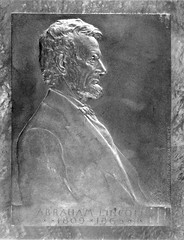 E-Sylum readers will recall last week our saga ended with determining the largest size die to strike the Lincoln portrait by Victor David Brenner from his 1907 Lincoln Plaque was slightly larger than five inches. But what to put on the reverse?
E-Sylum readers will recall last week our saga ended with determining the largest size die to strike the Lincoln portrait by Victor David Brenner from his 1907 Lincoln Plaque was slightly larger than five inches. But what to put on the reverse?
Obviously a portrait of Brenner himself. My partner, Mark Schlepphorst, had recently met Don Everhart, one of the engraver-sculptors at the Philadelphia Mint. "I want to commission Don to do the reverse," Mark told me. I couldn't agree more, an ideal choice.
After contacting Don by phone, he agreed to design and model such a Brenner portrait provided he could get clearance to do an outside commission from Mint officials. The three of us began discussions about what kind of Brenner portrait. Then I remember I had a photo in my file of Brenner seated at his work bench. What could be better? I sent it off to Don.
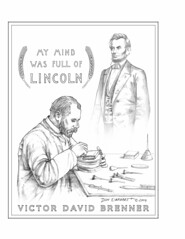 He liked it. In our father discussions I mentioned a phase I found researching an article for Coins Magazine in 1971. I even used it as the title "My Mind Was Full of Lincoln!!" Brenner made that statement to newsmen on August 2, 1909 when the first Lincoln cents were released in the financial district of New York City, and newsmen contacted him for comments.
He liked it. In our father discussions I mentioned a phase I found researching an article for Coins Magazine in 1971. I even used it as the title "My Mind Was Full of Lincoln!!" Brenner made that statement to newsmen on August 2, 1909 when the first Lincoln cents were released in the financial district of New York City, and newsmen contacted him for comments.
We all three agreed that could be the inscription. Then it was obvious to put a portrait of Lincoln as an ethereal vision in Brenner's mind on the reverse as well. But how could that be portrayed?
We tossed that design problem to artist Everhard. Don met the challenge head on. This modern medallist came back with a sketch that wowed both Mark and myself. We were ecstatic. He even added a touch of charm, encircling the inscription with wheat sheaves from Brenner's original reverse design.
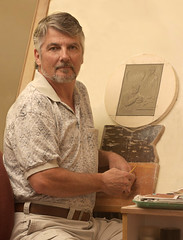 Coupled with Brenner's original Lincoln portrait that led to the Lincoln cent -- everyone knows the story of Brenner showing that Lincoln portrait plaque to President Theodore Roosevelt who instantly wanted it to appear on a coin -- Everhart's reverse design would make a stunning medallic item.
Coupled with Brenner's original Lincoln portrait that led to the Lincoln cent -- everyone knows the story of Brenner showing that Lincoln portrait plaque to President Theodore Roosevelt who instantly wanted it to appear on a coin -- Everhart's reverse design would make a stunning medallic item.
We commissioned Don to get permission and prepare the model. Four weeks later he had the design rendered into clay, working evenings and weekends. The money we agreed to pay him for this commission doesn't began to compensate this highly creative, innovative, professional medallic artist. "Can we do something more for you, can we prepare, for example, your biographical entry for Wikipedia?" He agreed.
After a Sunday morning interview gathering all the data about this artist, I drafted an entry in the Wikipedia format. Emailed to Don for fact checking, then to Mark with a corrected version. He placed this in Wikipedia's "sandbox" -- that is their term -- Mark added the photos and sent it off into Wikipedia's vast databank. Readers can access this at: en.wikipedia.org/wiki/Don_Everhart
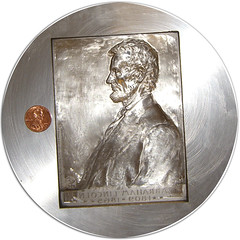 Meanwhile back at the ranch at Medallic Art Company in Dayton, Nevada, Bob Hoff had a die made from the original 1907 mold still residing the firm's vaults since it had been obtained, along with the rights to reproduce it, from Sam Brenner in 1929 (mentioned in last week's E-Sylum).
Meanwhile back at the ranch at Medallic Art Company in Dayton, Nevada, Bob Hoff had a die made from the original 1907 mold still residing the firm's vaults since it had been obtained, along with the rights to reproduce it, from Sam Brenner in 1929 (mentioned in last week's E-Sylum).
The die came out perfect. At the same time we had approved Don Everhart's clay model. He cast this in plaster and sent it off to Medallic Art to make the companion reverse die to fit that Lincoln obverse.
Last week I mentioned there were peaks and valleys, elations and frustrations in this saga. This was all peaks and elations. The frustrations were yet to come. There is more to this story. More next week.
To read the earlier E-Sylum article, see: DICK JOHNSON: LAUNCHING A NEW MEDAL AND A NEW BUSINESS (www.coinbooks.org/esylum_v12n41a09.html)
QUERY: INFORMATION ON TEMPERANCE SOCIETY MEDALS AND TOKENS SOUGHT
Somewhat related to the recent article posted on the subject of "chips' carried by many members of Alcoholics Anonymous, there are a number of medals dating back to the 1830's that were issued by various "Temperance Societies". Maybe someone can add more comprehensive information than I present here, since I have but a few different pieces, and can give only a few scattered facts here that I happen know about them.
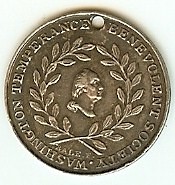
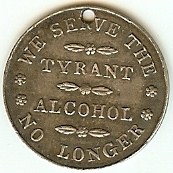
One of the earliest pieces that I know of is a bit larger than dime-size (21 mm), and was struck in silver in the mid 1830's. It pictures a bust of Washington on the obverse, surrounded by a fanciful wreath and with an outer legend "Washington Temperance Benevolent Society". These scarce pieces have sold in recent times for well over a thousand dollars, indicating a serious interest in this series by at least a few collectors. The reverse of this piece proclaims "WE SERVE THE TYRANT ALCOHOL NO LONGER" .
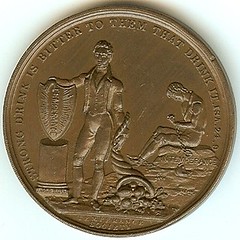
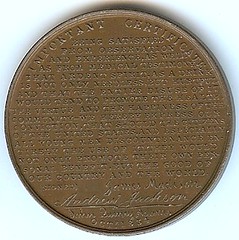
Another piece of particular interest is a bronze, 44 mm one dated "Oct'r 1834", and includes the die-struck signatures, in script, of "James Madison", Andrew Jackson", and "John Quincy Adams". These three notables are allegedly endorsing this "IMPORTANT CERTIFICATE" which reads quite interestingly:
Being satisfied from observation and experience, as well as from medical testimony, that ardent spirit, as a drink is not only needless, but hurtful, and that the entire disuse of it would tend to promote the virtue and the happiness of the community, that should the citizens of the United States, and especially all young men discountenance entirely the use of it, they would not only promote their own personal benefit, but the good of our country and the world" (signed) James Madison Andrew Jackson John Quincy Adams Oct'r 1834"
The obverse dramatically depicts a 'sober' man holding a cornucopia and leaning on a shield inscribed "TEMPERANCE". By contrast, next to him is the seated figure of a dejected man with his feet and hands bound in chains, and sitting on a rock inscribed "INTEMPERANCE". The obverse inscription reads 'STRONG DRINK IS BITTER TO THEM THAT DRINK IT" And at the bottom "TEMPERANCE SOCIETY"
Are there any readers who might be able to point us to any previously written literature on the series of temperance medals? To read the earlier E-Sylum article, see: MORE ON ALCOHOLICS ANONYMOUS TOKENS (www.coinbooks.org/esylum_v12n41a15.html)
MORE ON THE 1783 NOVA CONSTELLATIO PATTERN SET
Bruce Lorich writes:
That was a delightful read, your various snippets about Ford's most important coins. I chuckled at the comment about the delight of being able to look at the coins in the large plastic holder, the closest most numismatists have gotten to the coins.
I chuckled because I was one of the few who actually touched the coins, held them in my hands, and studied them at length with a loupe, back in 1979. Auction viewers never got to touch them, only see the coins through large plastic flips. A few of us staff numismatists at Bowers & Ruddy Galleries were the luckiest of all -- John Murbach, Bob Korver, Rich Kosta, Jim Jones -- as well as the staff photographer, Jim Clutterbuck, who took the images that appeared in the Garrett sales catalogues.
Dave Bowers probably saw these pieces more than the rest of us, but Jim Ruddy had retired, so even he never handled the coins. My private hour or so with the Novas back in 1979 is one of my best memories of my five years at the firm. Thanks for publishing all those disparate details about the set.
Dave Bowers writes:
In my opinion -- and I have no vested interest of any kind -- the 1783 Nova Constellatio patterns are candidates for the very most important (and I won't even mention value) American coins. They "suffer" from their rarity--most are unique, while, for example, there are fifteen 1804 silver dollars.
As to lighting of exhibits, one does not want to put much light on paper money at all, as it might harm the notes. The National Postal Museum in Washington, DC, keeps many stamps in virtual darkness. Nor would one want to blast spotlights on the Nova patterns as they might change color!
The Whitman Coins & Collectibles Expo in Philadelphia, with its exhibits and the Stack's Americana Sale, was a nice return to what I consider to be traditional numismatics--the very foundation of our wonderful hobby.
At the Whitman Coins & Collectibles Expo in Philadelphia a couple weeks ago I had the pleasure of appearing on Fox 29 TV News at 7:20 on Thursday morning I met the Whitman security contingent in the lobby of the Marriott Courtyard, a very nice hotel that used to be the City Hall Annex. This was just a short walk away from the Convention Center where the show was held. Along to supervise things was Guy McCullough, publicist for Whitman. Security was tight, as you can imagine.
Not long afterward we arrived at the Fox station, a nice ground-floor facility with a pleasant staff. Going through my mind was what to say on the upcoming show, taking care, of course, to be "fair and balanced," per the Fox motto! Not to worry about the subject content, however, as just about anything concerning rare coins and their value is of interest to television viewers.
In the Green Room, as waiting rooms are usually called at stations, I met Glenn Macnow, a local radio sports talk show host, who had with him a rare "Lincoln penny." Glenn said that while he collected coins as a youngster, he no longer did so, but cannot resist looking through pocket change each day to see if any "wheat" cents can be found. This particular item was a little treasure all on its own, as the obverse was 1909-S! Unfortunately, there was no "V.D.B." on the reverse. Glenn said he had checked on the Internet and concluded that it would be worth $150.
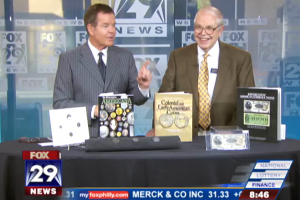
In due course, I, Guy McCullough, and the security contingent were ushered into the filming studio. On the air was Mike Jerrick, anchor and interviewer, who, as might be expected, viewed just about everything on the day's news as being memorable, fascinating, and exciting. In appearance he resembled Regis Philbin, but a generation younger.
In due course, Glenn Macnow went before the cameras with his rare "penny" and discussed it. Jerrick and Macnow knew each other well, one being prominent in television and the other in radio, and they exchanged pleasantries.
In the meantime, on a nearby table, again under security, rare items from the Whitman Show were displayed. On the right was the $1,000 Series of 1890 Coin Note, the famous "Watermelon Note," from the large zeroes on the back, looking like juicy watermelons. This particular piece of paper money was the first in the world to cross the auction block for more than a million dollars.
This was on a little easel all its own, with the front of the note facing forward. Prior to going on camera I lifted the note and turned it around so the all-important (at least from a numismatic viewpoint) back would be visible. The cameraman came back over and changed it the way he had it to begin with, stating that television audiences prefer people, such as the person depicted on the note, much more interesting than the other side. Oh, well!
In the foreground to the left was a set of three Sansom silver medals, struck in Philadelphia early in the 19th century, and depicting events in American history. To specialists these are well-known classics, from dies by John Reich, with interesting motifs, the reverses being particularly memorable (in my opinion).
On another easel was the holder containing the unique 1783 set of Nova Constellatio pattern coins. For good measure, the catalogue of the Stack's Americana Sale plus a couple of my books furnished the background. Quite attractive overall. Soon it was my turn, and Mike Jerrick came over to the display, with some "rarities" in his hand. Showing me pocket change coins one after the other I remarked that they were of no particular value and could be spent.
Then came a brass Chuck-E-Cheese token. "What is that worth?" he asked. I suggested that it might indeed be worth a hamburger. The talk turned to the items on display, and I explained them, lifting the Grand Watermelon Note out of its easel and showing the back side. The cameraman seemed to take it in good stride, and the show went on. Then came a discussion of the other items. In my opinion the Nova Constellatio set, of which have nice memories of cataloguing it way back when auctioning the Garrett Collection for The Johns Hopkins University, is probably the most single historical group in federal coinage, without exception.
At the Garrett Sale John Ford was set on buying these. He had a complex plan, which involved his sitting in the front row and bidding, but after he stopped, his friend, Herbert I. Melnick was to continue, following some prearranged signal. Melnick bid on a particular lot, then stopped, much to the consternation of Ford, who didn't want to lose it, and had to speak out, revealing the little deception.
Bidding continued by Ford, and he wound up capturing the pieces he desired, except for a variety of one denomination that went to Walter Perschke, a Chicago dealer. These then became the pride and joy of the Ford Collection. He wrote about them extensively, did further research, and added a copper piece to the group. Years later the set was sold in a private transaction by Stack's, to the present owner, who shared it with visitors to the Philadelphia Expo.
Chatting continued, drawing to a close as Mike Jerrick picked up the Watermelon Note and showed it to me, then quickly said, glancing in the distance, "Look! There's Halley's Comet!" I turned to see what he was talking about, and he ran off the set holding the note and laughing. The show ended, after which, of course, the Watermelon Note went back where it belonged.
The television show seems to have been quite widely watched, as many people came to the Whitman Expo that day and later. One of them was a man with his young son, Andrew, with an old $100 bill and dozens of old coins that belonged to the family. We chatted about coins for a time, and he seemed to want to know more. With Andrew watching the items spread out on Stack's table, I took the father over to the nearby Whitman booth and encouraged him to buy a Guide Book of United States Coins, which he did. Who knows? Perhaps we now have a new collecting family.
The Whitman show itself was really great. The attendance was good, there was general enthusiasm, and most dealers with whom I talked felt that I was a very welcome change to what were viewed as a couple of fairly dead conventions in late summer and September. To be sure, the Whitman Expo wasn't bursting in the seams, and fireworks weren't exploding, but there was a general level of basic enthusiasm of the old-fashioned kind. It was a good way for the numismatic community to enter the autumn season.
At the Stack's Americana Sale there was lots of excitement when several specialties crossed the block, most notably the Chet Krause Collection of Wisconsin Obsolete Paper, which broke just about every auction record in the book, and the section on American tokens and medals, including items that once belonged to famous sculptor Chester Beach.
At show's end the general comment was that collectors and dealers could hardly wait until the encore show, which Whitman has scheduled for September 2010. See you there!
Dennis Tucker of Whitman Publishing forwarded this link to a video of the newscast. Check it out!
Get Your Rare Coins Checked By Dealers
(www.myfoxphilly.com/dpp/good_day_philadelphia/092409_
Coin_Expo_Comes_To_Town)
Bob Neale writes:
Regarding the following excerpt from your earlier writing as presented in the latest E-Sylum about the Nova Constellatios:
The coins were struck in April 1783 for Robert Morris, and were the first attempt to create a national coinage for the new government. The denominations were based on a unit equal to 1/440th of a Spanish Milled Dollar. The silver "mark" was 100 units, the "quint" 500, the "bit" 100. The smallest was a copper "5".
My understanding, as I published in my article on Mr. Jefferson's Money in the Nov 05 Numismatist (specifically on p 43), is that Morris' reached a common denominator to account for all the different monies for a new unit of account that had to equal 1/1440 of an average Spanish dollar (not 1/440), with a silver mark at 1000 units, but the rest (quint and bit) as you wrote. That would have made the new mark equal to 25/36 of a Spanish dollar, hardly a convenient conversion aid.
Another E-Sylum reader writes:
"Nova Constellatio's" that were on recent display along with the other rarities was meant to entice attendance to the new Philadelphia Whitman show. This was a deliberate decision to help make the show a regular "must" attend show and of course profitable.
David Crenshaw does a great job hosting and creating a show. The pressure on him must be tremendous and he deserves our respect and gratitude when we attend for what he goes through so that we can conduct our hobby and business pleasurably. His support staff and co-workers also have stress and pressure and they too are underappreciated. From Mary Counts on down all the employees at Whitman work hard for our benefit. They don't have easy jobs and they at least deserve our recognition.
The "Nova Constellatio" set of four coins is indeed impressive AND they were in fact the original four coins that were presented to the committee of the Congress of the Confederation in April 1783. John J. Ford was a brilliant man who knew what he was doing when he reassembled the set at all costs. This set of coins is not and was not the first pattern coins for the United States, however.
It is the second issuance of patterns and it was for the Congress of the Confederation struck under and for Robert Morris in Philadelphia. In late 2008, I offered for sale through private treaty the very first pattern, which preceded the "Nova Constellatio" set to a "Southern Gentleman". It was one coin that John J. Ford tried to buy and failed to purchase during his life, but he knew what it was and what it meant.
Walter Breen (who was employed by Mr. Ford) published disinformation in his "Complete Encyclopedia" in 1986 in an attempt to assist Mr. Ford in his acquisition of the coin. Disinformation is still printed to mask the value and nature of this coin. In the future I will publish all of my research on the topic, but needless to say it is the Most Valuable Coin in American Numismatics and it is wholly Unique.
The current owner of the "Nova Constellatio" set has a prize to be proud of and displaying them for the world is beneficial. Please donate them to the National Numismatic Cabinet in the Smithsonian for all the people to appreciate. That is where they truly belong.
To read the earlier E-Sylum article, see:
NOVA CONSTELLATIO PATTERN SET SURFACES IN PHILADELPHIA
(www.coinbooks.org/esylum_v12n41a10.html)
This lot includes a large bound pamphlet entitled 12TH DOLLAR RELEASED FROM 1ST 100 EVER COINED AT DENVER MINT. THOMAS ANNEAR SUPT. [1921]. The front cover of the pamphlet also states:
Contained between these covers are copies of the auction catalogue descriptions, antiquarian documents and published articles over the year concerning this unusual rare coin and its eleven sister coins and of the historical event that caused their existence.
A $22,000 reward is being offered for information leading to the arrest and conviction of the thief or thieves who stole coins Oct. 11 from the car of Silver Spring, Md., coin dealer Julian Leidman.
The Numismatic Crime Information Center reports that a side window of Leidman's car was smashed and the coins removed. Leidman was returning from Coinfest, a show held over the weekend in Stamford.
The dealer community is banding together to help law enforcement solve the case. The reward stands at $22,000 as this is written, but it started out yesterday at $5,000 with the initial reward offer of Coinfest founders Laura Sperber and Jon Lerner through the Professional Numismatists Guild. Other PNG dealers followed.
Identifiable inventory items according to NCIC includes:
Three contact phone numbers have been given for the use by anyone who can help with information.
To read the complete article, see:
Dealers Rally to Solve Crime
(www.numismaster.com/ta/numis/Article.jsp?ad=article&ArticleId=8011)
We urge Any Dealer or Collector to contact Detective Christopher M. Keezer of the Montville NJ Police Department at 973-257-4113 (CKeezeer@MontvilleNJ.org)or Julian Leidman at 301-585-8467 if they have any information about this crime, or think that any of the coins listed below are being offered for sale either online or in person. This is especially true for those attending flea markets, local auction houses, online auctions and "Brick and Mortar" coin shops on the East Coast.
To read the complete article, see:
Coin Dealer Julian Leidman Victim of Vehicle Burglary. Reward Grows to $74,500
(www.coinlink.com/News/featured/coin-dealer-julian-leidman-victim-of-vehicle-burglary/)
1806 HALF DOLLAR O-123 Gem Proof-like Uncirculated - My client has owned this piece for at least thirty years, having purchased it from Ed Milas of Rarcoa in Chicago. It is a very well struck example of O-123 without any die breaks and is far scarcer than a normal 123 that has die breaks and a weakly struck reverse center. The coin is wholly proof-like and naturally toned Gem Uncirculated specimen
1807 O-113 HALF DOLLAR PCGS MS65, GEM Uncirculated, Small Stars - This coin is a spectacularly toned GEM Uncirculated, prooflike, and the finest known 1807 half, period. Ex. lot #296 Lester Merkin's sale of 3/15/67, an incredible offering of early halves following his landmark offering of the Helfenstein Large cents and dimes in his 4/66 auction, Lester raved about this coin.
ENGRAVED #12 1921-D MORGAN DOLLAR Gem Toned Uncirculated, the 12th coin released-This is the 12th Silver Dollar released from the first 100 coins struck in Denver. The first two coins were presented to two Colorado institutions, one being the School of Mines, were not engraved. Neither of these coins is currently known. The 3rd coin thru the 12th are engraved as follows:
I believe that all of the 10 engraved coins are known today. The other 88 coins were not engraved and are not traceable.
1929 Five Reichmark Off-Center error
1873 NGC PF 65 Proof Silver Trade Dollar Judd Pattern
Serial Number 84 Currency Collection:
Currency Collection (65 Notes Total) With Serial #'s of 84
This is a unique collection that I have been working on for over 30 years. Some are circulated and many of them are crisp uncirculated
Sword-in-hand Colonial Note
Massachusetts, August 18, 1775, the very famous Sword in Hand design, 11 shillings, fully issued with 3 signatures, re-dated in ink, 8/7, the only one ever seen by Eric P. Newman, THE expert in the series. Much finer than the 2 signature example in the incredible John J. Ford collection.
Other Colonial Currency
Alan V. Weinberg (retired LAPD) adds:
Many express the hope that the easily-identifiable coins, of which there are many according to the inventory, will walk into a coin shop or be offered at a coin show.
That depends. There are two scenarios. One is an unplanned, moment of opportunity by some unemployed, drugged out or evil-minded habitual thief or even a teenager who spots a briefcase or two in plain view on an unattended car seat. He breaks the window and makes off with the cases. Then, there is a good chance the material will end up at a flea market or on eBay or in a coin shop or show.
The other scenario, much more likely in my opinion, is a skilled, planned, surveilled grand theft by at least two cars of experienced coin and jewelry show thieves who target their victim during a show, watch for him (from a distance) outside at show closing and follow him home, using car to car communication.
They will follow the dealer as long as it takes for him to either stop for a meal or a restroom, or until the dealer is on an isolated stretch of road where they can shoot out his tire or his radiator, the dealer stops and then is at the mercy of the swarm of thieves. Indeed, as with early copper dealer Tom Reynolds victimized by Russian organized crime some years ago, they can even follow the dealer to his home doorstep or his shop, several states away, where he feels he is safely at home and can relax.
If it is organized crime, the coins will be much more skillfully fenced, perhaps stored away for years, perhaps sold in Europe, perhaps held for ransom with the insurance company. Organized criminals have multiple identifications, are often in the US illegally or on overstayed visas, aren't afraid of being caught, and , if they are, are too often trivially sentenced as the Criminal Courts regard such "property crimes" as non-violent and a matter between the victim and his insurance company.
Some have speculated whether the FBI will get involved. Only if they perceive a ring of skilled criminals are involved in multiple crimes in multiple venues and/or if they perceive the crime was an interstate effort, that is, the victim was trailed from one state to another with the criminals following. Then it is a Federal matter. If the Feds "blow it off" as an isolated opportunity crime by a local criminal , there's no Federal involvement.
How to protect yourself from a similar incident? No guarantees but I like the idea of hand-carrying in your pockets - jacket and pants - your best and most valued, unreplacable coins and currency. And light-weight chaining your briefcase to your wrist if you have to stop and exit your car. And hiding your most valuable assets in the car wheel well while packing your trunk , leaving the briefcases atop with lesser material. Law enforcement in the show parking lots after a show and even en route to the airport has limited effect. These skilled theft rings watch you from a distance and follow you , using multiple observation personnel.
From a story in the Daily Record:
The inventory of more than 1,000 coins included individual pieces valued as high as $160,000, as well as many extremely rare and unusual coins and currency dating to the Colonial era, he said.
"It was a huge amount, seven figures," Leidman said, enumerating the loss. "This is the worst thing that has ever happened to me."
He believes he may have been targeted during Coinfest.
"I was one of the last people to leave the show, and there were a couple of women around -- one of which had been by my table a few times," he said. "When I left, she was sitting out at the reception area of the hotel and she was on her cell phone, and my wife said, 'The lady just said, 'They're on their way out.'"
To read the complete article, see:
Rare, valuable coins stolen in Montville
(www.dailyrecord.com/article/20091014/COMMUNITIES/310140017/1344/NEWS14)
Dick Johnson writes:
Thanks to Philippe de Henaut for his NIP N' TUCK suggestion. I award him my TOHAFAC (Tip Of Hat Award For Acronym Creation) Medal.
For more a much longer article on Dick Johnson's new enterprise, one E-Sylum reader suggests:
Sixteen area authors have teamed up to pen a serial novel, "The Coin," in which a mysterious coin kicks off a twisting, turning tale of intrigue, set right in Aiken County.
The concept of a serial novel is simple: One author writes a chapter and then passes it on to the next author. Since each chapter of "The Coin" is written by a different local author, the story brings in a diverse pool of voices and provides a suspense-filled story that will have readers dying to know what happens next and keep them guessing until the end.
To read the complete article, see:
'The Coin' serial novel coming Sunday
(www.aikenstandard.com/Local/100609-coin-story)
This was a 25-cent remainder find in April. I assume one of the authors is numismatically literate. I enjoyed the read and pass it on to you for your "morose delectation".
Florence Jackson beat 17,000 other entries to win a Blue Peter contest and work with the Royal Mint on her design, which shows a high jumper.
She said: "I am so excited. It was a real surprise to win. I'd never entered a Blue Peter competition before but really wanted to take part because I love drawing.
"I chose the high-jump because I'd watched it on TV and thought it looked fun. It was amazing to visit the Royal Mint and see my picture turned into a coin. I can't wait to see it in my pocket money!"
The coin will be the first in a series of 29 50p pieces that will commemorate London 2012. They will appear in circulation next year.
To read the complete article, see:
Florence Jackson, 9, wins competition to design coin to celebrate London 2012 Olympics
(www.mirror.co.uk/news/top-stories/2009/10/13
It was found with coins in both eye sockets – an old Greek tradition in which the money was used to pay passage for travel to the underworld.
When discovered in a dig earlier this year the coins were so corroded that archaeologists were unable to tell what they said.
But months of painstaking restoration work have revealed one is a medal featuring a kneeling slave engraved with the phrase 'Am I not a man and a brother?' and the other is a halfpenny made in Gosport in 1794.
Archaeologists behind the dig believe the skeleton is that of one of the first abolitionists from Britain and it is one of only three such skeletons ever to have been discovered in the UK.
Dr Andrew Shortland of Cranfield University, director of the excavation, said: 'This is a very rare find and it's unique at Haslar. We knew this was done, but it's very unusual.
'He would have been one of the first abolitionists, and the date on the coin has also given us the first date we've had too.
'We know he must have died after 1794, probably very soon after because these hand-made coins weren't in circulation for very long.
'We've never come across anything like this before. We've done some research and discovered that this is one of only three examples like this in the UK.'
To read the complete article, see:
Rare skeleton of anti-slavery sailor dug up
(www.portsmouth.co.uk/newshome/Rare-skeleton-of-antislavery-sailor.5735717.jp)
A dog owner has won £450 compensation after his pet pooch chewed a parcel.
Coin collector Bruce Goulborn's spaniel Benny munched £800 worth of rare £5 notes after a bungling postman got a neighbour to sign for his package.
Afterwards, he stuffed the item through Mr Goulborn's letterbox - and it ended up in the dog's mouth.
Yesterday, a court ordered Royal Mail to pay Mr Goulbourn, from Rhyl, Wales, £450 as the damaged notes are now worth only £350.
He said after the case: "Benny thought it was his birthday when the package arrived. He sank his teeth right into it."
To read the complete article, see:
Dog eats up rare fivers worth £800
(www.mirror.co.uk/news/top-stories/2009/10/17/
This week's Featured Web page, compiled by Steven Gibbs, covers Guernsey & Sark Tokens
(including spurious tokens of the
Channel Islands occupation 1940-45).
THE BOOK BAZARRE
COIN DEALER JULIAN LEIDMAN VICTIM OF VEHICLE BURGLARY
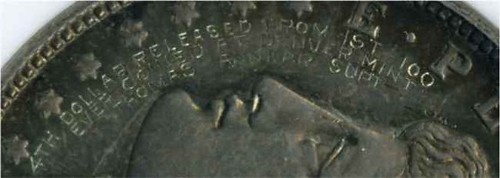
 After publishing my note I was contacted by my friend Julian Leidman, who told me he owned the lot and had the pamphlet in question, which had been prepared by a previous owner of the engraved dollar. He asked me to remind him to bring the pamphlet to the next meeting of our local numismatic social group Nummis Nova. Well, on Monday I sent him an email reminder, only to learn that the pamphlet had been stolen in a recently burglary of his car. The word spread quickly in the numismatic community - here are excerpts from some media accounts.
After publishing my note I was contacted by my friend Julian Leidman, who told me he owned the lot and had the pamphlet in question, which had been prepared by a previous owner of the engraved dollar. He asked me to remind him to bring the pamphlet to the next meeting of our local numismatic social group Nummis Nova. Well, on Monday I sent him an email reminder, only to learn that the pamphlet had been stolen in a recently burglary of his car. The word spread quickly in the numismatic community - here are excerpts from some media accounts.
When I was about twelve our home was broken into and my fledgling coin collection stolen. Ever since I've had a safe deposit box for storage, but dealers on the road don't have that option. The dollar value was vastly different, but the sick feeling I'm sure is the same. Our sympathies to Julian - here's hoping someone in the numismatic community (maybe even an E-Sylum reader!) can provide information to break the case and put these thieves behind bars.
Below are Julian's descriptions of a few of the recognizable items.
Thanks. -Editor
ever coined at Denver Mint
Thomas A. Annear Supt."
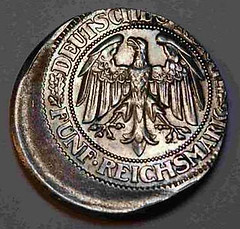
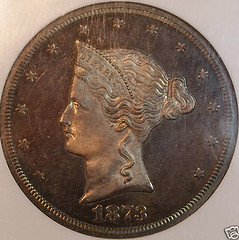

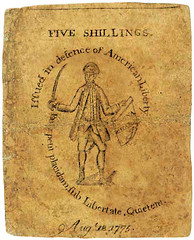
[Illustration is NOT Julian's note - Editor]
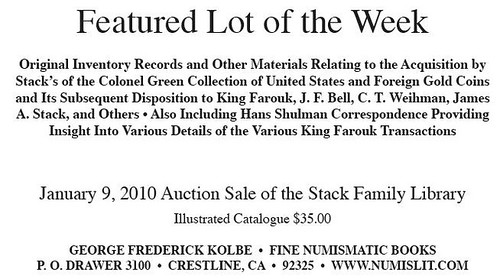
NOTES AND COMMENTS ON LAST WEEK'S ISSUE
NUMISMATICS IN FICTION: 'THE COIN' AND 'LOOSE COINS'
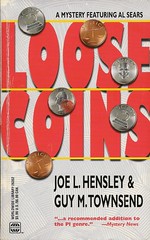 On a related note, Harry Waterson writes:
On a related note, Harry Waterson writes:
NINE-YEAR-OLD GIRL DESIGNS COIN FOR LONDON 2012 OLYMPICS
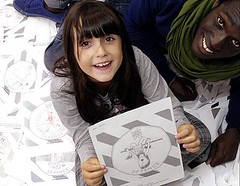 A girl of nine has won a competition to design a 50p coin to celebrate the London 2012 Olympics.
A girl of nine has won a competition to design a 50p coin to celebrate the London 2012 Olympics.
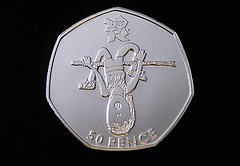 Florence, from Bristol, is the first child to design a UK coin. She was joined at the Royal Mint for the striking of the first one by Olympic gold medallist Denise Lewis and Blue Peter presenter Andy Akinwolere.
Florence, from Bristol, is the first child to design a UK coin. She was joined at the Royal Mint for the striking of the first one by Olympic gold medallist Denise Lewis and Blue Peter presenter Andy Akinwolere.
/small-change-115875-21743297/)
DEAD MAN'S EYE COVERED WITH AN ANTI-SLAVERY TOKEN
 The skeleton of one of the first sailors to join the movement to abolish slavery has been discovered in a dig at Royal Hospital Haslar in Gosport.
The skeleton of one of the first sailors to join the movement to abolish slavery has been discovered in a dig at Royal Hospital Haslar in Gosport.
THE DOG ATE MY PAPER MONEY COLLECTION
dog-eats-up-rare-fivers-worth-800-115875-21753292/)
FEATURED WEB PAGE: GUERNSEY TOKENS

www.guernsey.net/~sgibbs/numismatics/tokens.html
